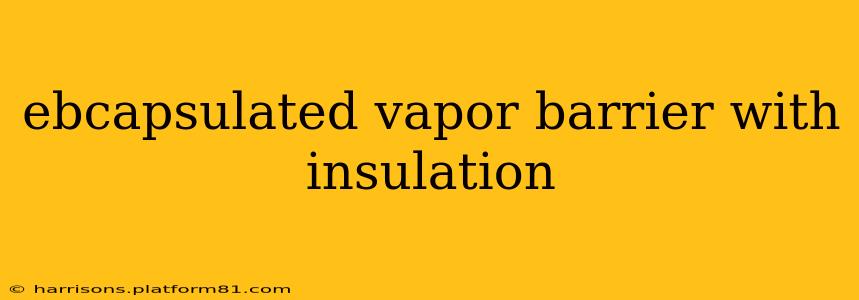Choosing the right insulation and vapor barrier is crucial for a healthy, energy-efficient home. Encapsulated vapor barriers, often integrated with insulation, offer a unique approach to managing moisture and improving thermal performance. This guide delves into the details of encapsulated vapor barriers with insulation, exploring their benefits, drawbacks, and applications.
What is an Encapsulated Vapor Barrier?
An encapsulated vapor barrier is a continuous layer of material, usually plastic sheeting like polyethylene, that's sealed within a larger assembly. This assembly often includes insulation, creating a complete, integrated system. The encapsulation process ensures the vapor barrier remains intact and performs as designed, preventing moisture intrusion. Unlike traditional vapor barriers applied separately, this method reduces the risk of tears, gaps, and other vulnerabilities that can compromise performance.
What are the Benefits of Using an Encapsulated Vapor Barrier with Insulation?
Using an encapsulated vapor barrier with insulation offers several significant advantages:
-
Improved Thermal Performance: The combined system enhances insulation efficiency by minimizing thermal bridging (heat transfer through structural elements). The continuous barrier reduces air movement within the wall cavity, preventing convective heat loss.
-
Reduced Moisture Problems: A properly installed encapsulated vapor barrier prevents moisture from entering the wall assembly, reducing the risk of mold, mildew, and rot. This is particularly crucial in climates with high humidity.
-
Enhanced Durability: The encapsulation protects the vapor barrier from physical damage during installation and over the building's lifespan. This leads to a more durable and longer-lasting system.
-
Simplified Installation: Compared to installing a vapor barrier and insulation separately, the integrated system often simplifies the construction process, potentially reducing labor costs.
What are the Drawbacks of Using an Encapsulated Vapor Barrier with Insulation?
While offering many benefits, encapsulated vapor barriers with insulation also have some potential drawbacks:
-
Higher Initial Cost: Integrated systems might have a higher upfront cost compared to purchasing and installing insulation and vapor barriers separately.
-
Difficult Repairs: Damage to the encapsulated system can be more challenging and expensive to repair than damage to a traditional system. Often, replacing a section requires significant disassembly.
-
Limited Flexibility: The integrated nature of the system limits flexibility in design and retrofitting compared to systems with separately installed components.
What Types of Insulation are Commonly Used with Encapsulated Vapor Barriers?
Several types of insulation are commonly used within encapsulated vapor barrier systems, including:
- Extruded Polystyrene (XPS): Known for its high R-value and moisture resistance.
- Expanded Polystyrene (EPS): Offers good insulation value and is relatively lightweight.
- Polyisocyanurate (Polyiso): Provides excellent thermal performance and is often used in high-performance building envelopes.
- Mineral Wool: While less common in encapsulated systems, mineral wool can be incorporated in some designs.
How Does an Encapsulated Vapor Barrier Differ from a Standard Vapor Barrier?
The key difference lies in the installation and protection. A standard vapor barrier is typically installed separately, often as a sheet or membrane applied directly to the framing. This approach leaves it vulnerable to damage during construction and throughout the building's life. An encapsulated vapor barrier is protected within the insulation assembly, minimizing damage and ensuring continuous performance.
What are the Common Applications of Encapsulated Vapor Barriers with Insulation?
Encapsulated vapor barrier systems find applications in various building types:
- Exterior Walls: Providing superior moisture protection and thermal performance in walls.
- Roofs: Creating a high-performance, weather-resistant roofing system.
- Foundations: Reducing moisture intrusion in basements and crawl spaces.
Is an Encapsulated Vapor Barrier Right for My Project?
The suitability of an encapsulated vapor barrier depends on various factors, including climate, building type, budget, and specific project requirements. Consulting with a qualified building professional is crucial to determine the optimal approach for your situation. Proper design and installation are paramount to realizing the benefits of this technology.
Conclusion
Encapsulated vapor barriers with insulation offer a promising approach to building envelope performance, combining moisture protection and thermal efficiency. While higher initial costs and limited repair accessibility are potential downsides, the enhanced durability, improved energy efficiency, and simplified installation make them a viable option for many projects. However, careful planning and professional installation are essential for optimal results.
